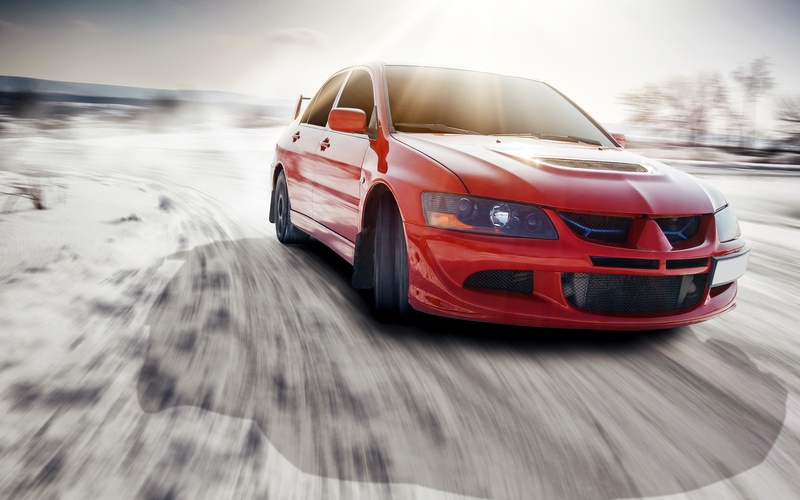The Complete History of the Mitsubishi Lancer Evolution

The Mitsubishi Lancer Evolution, also known to its many fans as the "Evo," is more than just a performance car; it’s a motorsport legend that has captured hearts across generations of auto enthusiasts. With its roots firmly planted in rally racing and its reputation cemented by exceptional engineering, the Evo stands as a symbol of power, agility, and driving passion.
Even though it’s no longer in production, the Evo is still a popular choice for many performance enthusiasts and even amateur racers. Below, we’ll go over the complete history of the Mitsubishi Lancer Evolution, from its first generation in 1992 to its final model in 2016.
Racing DNA: The Birth of the Lancer Evolution
The Mitsubishi Lancer Evolution comes from a legacy defined by speed and competition. Mitsubishi’s motorsport history began with a focus on rally racing in the 1970s, when the brand competed in events such as the Safari Rally, securing several notable wins. It was through these successes that the company discovered the growing demand for rally-inspired road cars. This realization culminated in bringing its rally experience to the streets with the Mitsubishi Galant VR-4, a precursor to the Lancer Evolution.
By the early 1990s, Mitsubishi had refined its strategy by shifting focus from the midsize Galant chassis to the more compact, agile Lancer platform. The result was a raw, turbocharged beast engineered with rally dominance in mind: the Lancer Evolution.
Lancer Evolution I–X: A Generational Breakdown
The Lancer Evolution’s story spans 10 generations, each iteration an evolution (so to speak) of engineering excellence. Every model built upon the last, introducing performance tweaks, updated technology, and sharper designs that thrilled enthusiasts around the globe.

Evolution I (1992–1993)
The original Lancer Evolution set the stage with a turbocharged 2.0L 4G63 engine, delivering 244 horsepower and 228 lb-ft of torque. The lightweight Lancer chassis and all-wheel drive combination immediately established the Evo I as a potent contender on and off the track. It was strictly limited in production, ensuring that every unit delivered exclusivity to its owner.
Evolution II (1994–1995)
Mitsubishi didn’t wait long to refine its formula. Evo II introduced better aerodynamics and more responsive handling. The company slightly increased the power through targeted engine modifications, offering a more predictable and aggressive driving experience. This model also debuted enhanced suspension systems with rally stages in mind.
Evolution III (1995–1996)
Downforce and cooling were the priorities of the Evo III, as it sported a more aggressive front bumper and newly designed rear wing. With some fine-tuning, its 4G63 engine now produced 270 horsepower, cementing its ability to compete at increasingly higher levels. At this point, the Evo began carving a niche among performance-focused car-buyers globally.
Evolution IV (1996–1998)
With the introduction of the Evo IV, Mitsubishi remade its power delivery system. A dual-scroll turbocharger boosted torque response, and significant upgrades to its all-wheel-drive setup created what would become the bedrock of future generations. The aesthetic influence also grew with striking hood vents and a wider body stance, making the Evolution IV a visual force on roadways.
Evolution V (1998–1999)
The Evo V featured an enhanced suspension and a wider track to deliver precision handling—essential tools for tarmac-oriented rally stages. The adjustable rear wing highlighted Mitsubishi’s singular focus on aerodynamics, while the bolstered power output delighted petrol-heads. The Evolution V increasingly became a favorite among tuners, who saw it as the perfect canvas for modification.
Evolution VI (1999–2001)
Many tuners and Mitsubishi aficionados cite the Evo VI as the most lovable of the Evos, as it sported a mastery of balance between rally-performance aggression and street-legal refinement. It introduced features such as the active yaw control (AYC) system and a reworked cooling system that improved reliability under extreme conditions. Limited special-edition models, such as the Tommy Makinen Edition, made the Evolution VI even more desirable to drivers everywhere.
Evolution VII (2001–2003)
The Evo VII is the legendary model in a more transitional phase. Built on a larger platform, it showcased technologies such as active center differentials and advanced braking systems, making it more competent across varying surfaces. While some critics noted the larger chassis slightly reduced its nimbleness, enthusiasts celebrated its improved comfort and advanced tech.
Evolution VIII (2003–2005)
With the Evo VIII came a worldwide explosion in popularity. Mitsubishi catered to the North American market, where fans had eagerly anticipated this model’s arrival. Featuring the now-iconic inverted intercooler and offering selectable driving modes, the Evo VIII became a must-have for car-lovers and track warriors alike.
Evolution IX (2005–2007)
Cranking up the performance to another level, the Evo IX didn’t rest on the laurels of the Evo VIII. Equipped with Mitsubishi’s variable valve timing (MIVEC), it delivered more precise power across the RPM range. Minor aesthetic changes, including new wheels and enhanced downforce features, further established the Evo IX as one of the best options for amateur racers who wanted rally-bred performance.
Evolution X (2008–2016)
The Evo X became the swan song of Mitsubishi’s iconic series. It was a technological marvel, offering features such as a twin-clutch transmission (an industry leader at the time) and an aluminum-block version of the 4B11T engine. Its refined interior bridged the gap between sports-car capability and daily driver comfort. While its departure in 2016 broke hearts, the Evo X stands as an apex in the lineage.

The Crown Jewel of Motorsport Success
The history of the Mitsubishi Lancer Evolution wouldn’t be complete without touching on its supreme success in motorsport arenas. The Evo delivered multiple victories throughout its career in the World Rally Championship (WRC). Tommi Mäkinen’s achievements—including four consecutive drivers’ championships from 1996 to 1999—remain highlights of Mitsubishi’s motorsport legacy.
The Evo solidified its reputation as a car built for speed, agility, and dominance, gaining global admiration in both professional rallying and grassroots racing. Tuners appreciated its balance, modifiability, and reliability, making it a go-to choice for anyone seeking serious performance on a budget.
Cultural Icon and Pop Culture Phenomenon
Beyond racing accolades, the Lancer Evolution captured the cultural zeitgeist. Few cars symbolized petrol-head romance quite like the Evo. Its presence in significant franchises, such as the Fast & Furious movies and video games such as Gran Turismo, cemented its status as an icon for tuners and racers globally. The Evo wasn’t just a car; it was a character—a representation of turbocharged adrenaline and the pursuit of perfection.
The Enduring Legacy of the Evolution
Although Mitsubishi ended Evo production in 2016, its influence reverberates across the tuning world and grassroots racers to this day. While modern sports cars rely heavily on hybrids and advanced tech, enthusiasts continue to celebrate the Evo for its raw, visceral appeal. For amateur racers, the Evo remains a favorite due to its durability and affinity for modification, making it a worthwhile competitor even today.
Discover How Clutch Masters Can Upgrade Your Evo
At Clutch Masters, we recognize the Evo’s enduring appeal for enthusiasts and racers alike. If you have an Evo you want to upgrade to the highest level, there’s no better place to find aftermarket clutch kits that maximize performance than Clutch Masters. Whether you’re improving lap times or refining your daily driver, explore our range of racing clutches and other drivetrain essentials to give your Evo the edge it deserves. Explore Clutch Masters’ full range of products and take your performance to the next level.


